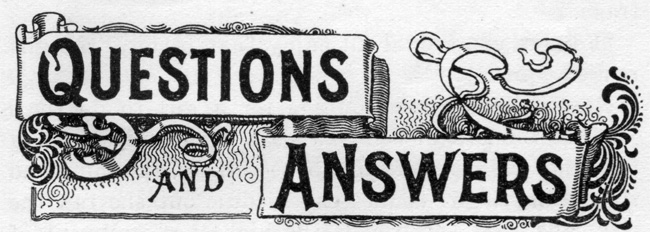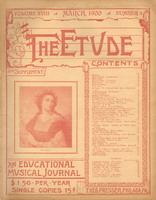 M. D.—Does composition require constant practice?
M. D.—Does composition require constant practice?
Ans.—Decidedly. Like literary composition, painting, chess, surgery, and every other human activity, musical composition requires constant practice. Composers will tell you that if they neglect to exercise their musical invention, their ideas will come very sparingly. The source of inspiration will run dry, as it were.
Sister B.— (a) No clue has been found to the title of Beethoven’s “Sonata Pathétique,” which was given by Beethoven himself. Nottebohm, in the “Neue Beethoveniana,” maintains that the finale of the sonata was originally written for strings, and was probably intended for the finale of the string trio in C-minor, opus 9, No. 3. (b) The waltzes mentioned are not to be found in the various catalogues. The names given: “Azalia,” “Gertrude’s Dream,” “Japonica,” etc., are probably due to the fertile imagination of some publisher. Nottebohm classes them among spurious compositions.
P. S. K.—Did Brahms ever compose an opera?
Ans.—No. Upon Hanslick interrogating him on the subject, he answered: “I would not care to compose in the Wagnerian style and the old classical style would have no success.”
L. B.—Jean Louis Dussek, 1761-1812, the friend of Prince Louis of Prussia, was a well-known pianist and composer. Some of his sonatas deserve to be rescued from oblivion. He was the first pianist who placed his instrument sideways upon the platform.
Mrs. G.—In the Chopin “Mazourka,” opus 6, containing grace note and chord, the grace note is struck first followed by the chord. The passage is rather difficult and can be facilitated by practicing the grace note with the upper note of the chord.
M. L. J.—1. The ordinary waltz tempo is from dotted half-note = 66 to dotted half-note = 72.
In the instance you mention,
dotted half-note = 88,
you could not have had thirty bars to a minute unless your metronome was out of order. You must necessarily get about 88 measures to a minute. Mr. Theodore Presser, of Philadelphia, has issued a pamphlet concerning the construction and use of the metronome —accompanying the sale of each instrument.
2. If I understand your question correctly, in a group of two grace notes accompanying another note, the three notes are played separately as three distinct notes.
3. The arpeggio sign placed over a chord horizontally must be a misprint.
4. The members of an orchestra tune according to the A (philharmonic pitch), given by the oboe.
5. Certain ornaments (agremens) are performed according to certain rules. They are subject to various interpretations. Russell’s “Ornaments in Music” will be useful in this connection.
C. G.—The most popular opera, according to latest statistics, seems to me “Mignon,” by Ambroise Thomas, which received its 1000th performance May 13, 1894. “Faust” received 1000 performances during the course of 35 years, in 1893—one year after the death of the composer. Mozart’s “Don Giovanni,” only received 500 performances during a period of 100 years.
L. G.—1. The music to “A Midsummer Night’s Dream” was written by Mendelssohn. The overture was written at the age of 17, and the other numbers 17 years later. The music to the whole play was composed at the instigation of the King of Prussia. The entire music consists of 13 numbers: overture, scherzo, fairy march, a number for two sopranos and chorus, melodrama, intermezzo, melodrama, notturno, andante, wedding march, allegro commodo, dance, and finale.
2. The C, popularly called common time, is not the third letter of the alphabet, as generally supposed, but is an unbarred semicircle: 
E. M. D.—1. The subject of an oratorio is generally based upon some religious motive (“The Messiah,” Händel; “Elijah,” Mendelssohn), whereas in an opera the subject is taken from legendary lore (“Lohengrin,” “The Ring of the Nibelungen”), history (“Ferdinand Cortez,” “Rienzi,” “Les Huguenots”), or real life (“Cavalleria Rusticana”). Some time ago Rubinstein tried to make a fusion of both oratorio and opera styles in what he called “sacred opera” (“The Macabees,” and others), but did not meet with great success. The dramatic characterization is naturally quite different between both types of music.
2. Two notes in the same measure with a slur connecting them are tied.
3. ![]() is equivalent to 2-2 time.
is equivalent to 2-2 time.
4. In Nevin the e is pronounced like in net and in like in machine. In Chaminade the ch is pronounced like sh in she, the i like in it and the a like in far.
5. The scale of G-flat has six flats. Enharmonically on the piano it is the same as F-sharp, which has six sharps. Thus, Chopin’s “Etude on the Black Keys” is written in G-fiat, while the “Bird Etude,” by Henselt, is written in F-sharp.
J. N.—Quite right. In the finale of “Don Giovanni,” last act, there is a musical quotation from “The Marriage of Figaro,” by the same composer—viz.: “Non pui Andrai.” In the “Meistersinger,” Act III, we suddenly hear the opening notes of the introduction to “Tristan und Isolde.”



